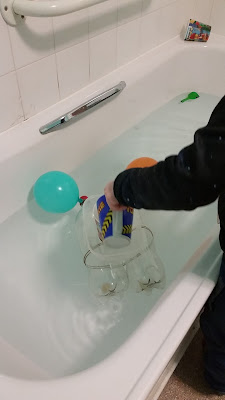So if you have been following our transport topic then you will know that following our visit to the London Transport museum the boys were keen on designing and making some boats.
We first had to see what materials worked best and what would float and what would sink. So after carrying out a little science experiment we took to making our designs.
The test was simple; create a boat that floats and is then able to support a cup of water without sinking.
James had a clear idea of what he wanted.
Following our research he decided that he wanted to use 2 milk bottles and to tie them together; to have them supported by string was something that occurred to the boys after William realised that if the materials float they can equally float away and apart from each other.
James was also keen on adding a balloon to his boat. His reasoning was quite clear from the start; the balloon was the hardest of all the different materials to submerse under the water and always came back up to the top. He also compared this to the balls (buoys) that boats have. After we tied the balloon to the front (his choice) we attached a small pot on top to hold the cup of water.
William has similar ideas to James when it came to the design.
He decided that he would use plastic bottles to float and chose bigger bottles, such as the larger coke bottles. He suggested that this would make the boat float better and carry more weight as the bigger materials in the test seemed to show that they displaced the water better.
He was also aware that the cup of water would be quite heavy and subsequently that the bottles had a greater chance of going below the water. To correct this he add an extra, smaller, bottle between the bigger two.
Now it came to the test.
James was first to see if his boat would float and luckily it did!
Next was to see if his boat would hold the weight of the cup of water. James' boat showed a lot of promise and it did start to work but at 3/4 full the cup toppled and the water emptied. This was mostly down to his keen nature to try it; he was filling the cup way to quickly and I believe it was this added pressure that made the cup fall.
On a second attempt, and with my guidance, his boat did hold the water but independently the cup always toppled.
It was now Williams turn. Like James, the use of the correct materials meant that his boat floated; the balloons also seemed to counter balance the shape difference in the bottles.
William did have an advantage though, he watched what James had done and with that filled his cup up slowly. He did really well and his cup stayed afloat but he wanted to try a little more. With this stage complete he started adding water to the pot as well, eventually not only filling the cup but the entire pot.
His prior understanding came through too, The higher amount of weight did shift the bottles to go lower but both the balloons and the middle bottle seemed to keep the balance correctly.
This was such a great activity and I am so pleased that we did it. The boys seemed to recall some good prior knowledge carried forward from the previous lesson and knew what would and wouldn't work. Each also had different unique design features and could give clear reasons for doing so.
The only problem we had was that we didn't make any sails or flags, much to the boys disappointment! Think this comes down the a Daddy error more that their understanding though!
What do you think of their boats and their ideas?








No comments:
Post a Comment